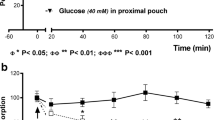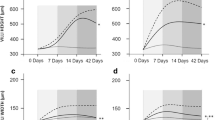Summary
The function of the intestinal mucosa immediately after one hour's ischaemia was examined by means of tests in vivo and in vitro. During the ischaemia, the intestinal loop was perfused with media of different compositions, in an attempt to assess which provided the best protection of the epithelium from the deleterious effects of the ischaemia. The absorption of water, ions and glucose was then monitored in vivo, and the uptake of phenylalanine and ß-methyl-glucoside by slices of mucosa was determined in vitro.
The unprotected mucosa loses all active transport capacity in vitro following one hour's ischaemia, and is the site of a pronounced loss of water and ions into the lumen in vivo. Glucose absorption in vivo is also abolished. If the loop is perfused during the ischaemia with glucose-containing Krebs bicarbonate buffer, much of the transport capacity in vitro is retained; the loss of ions and water is prevented, and glucose absorption in vivo occurs. Perfusion during the ischaemia with other media, such as isotonic mannitol, Krebs bicarbonate buffer, or Ringer-lactate solution, results in a marked protection of the mucosa, in comparison with the unperfused loop, but the effects are not as pronounced as those of the glucose-containing buffer. It is concluded that the act of perfusing the intestine is the most beneficial factor, but that the presence of glucose in the perfusate does afford added protection.
Similar content being viewed by others
References
BOUNOUS, G.: Role of intestinal contents in the pathophysiology of acute intestinal ischemia, Amer. J. Surg.114 368–375 (1967)
CHIU, C.-J., SCOTT, H.J., GURD, F.N.: Intestinal mucosal lesion in low-flow states. II. The protective effect of intraluminal glucose as energy substrate, Arch. Surg.101 484–488 (1970)
HUECKEL, H.J., CHIU, C.-J., HINCHEY, E.J.: The effect of intraluminally administered glucose in reducing fluid and electrolyte loss from the ischemic intestine, Surg. Gynec. Obstet.136 780–784 (1973)
LISON, L.: Statistique appliquée à la biologie expérimentale, p. 230. Paris: Gauthier-Villars 1968
McARDLE, A.H., CHIU, C.-J., GURD, F.N.: Intraluminal glucose, substrate for ischemic intestine, Arch. Surg.105 441–445 (1972)
MIRKOVITCH, V., MENGE, H., ROBINSON, J.W.L.: The effect of intraluminal hydrostatic pressure on intestinal absorption in vivo, Experientia30 912–913 (1974)
ROBINSON, J.W.L., ANTONIOLI, J.-A., MIRKOVITCH, V.: The intestinal response to ischaemia, Naunyn-Schmiedebergs Arch. Pharmak. exp. Path.255 178–191 (1966)
ROBINSON, J.W.L., MIRKOVITCH, V.: The recovery of function and microcirculation in small intestinal loops following ischaemia, Gut13 784–789 (1972)
SALTZMAN, D.A., RECTOR, F.C., FORDTRAN, J.S.: The role of intraluminal sodium in glucose absorption in vivo, J. clin Invest.51 876–885 (1972)
Author information
Authors and Affiliations
Additional information
On leave of absence from the Medizinische Univesitäts-Klinik, Marburg/Lahn.
Rights and permissions
About this article
Cite this article
Mirkovitch, V., Menge, H. & Robinson, J.W.L. Protection of the intestinal mucosa during ischaemia by intraluminal perfusion. Res. Exp. Med. 166, 183–191 (1975). https://doi.org/10.1007/BF01851184
Received:
Issue Date:
DOI: https://doi.org/10.1007/BF01851184




